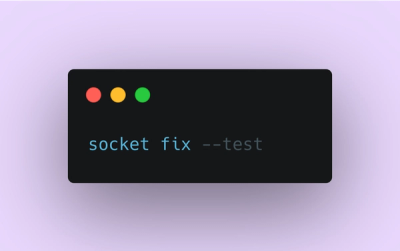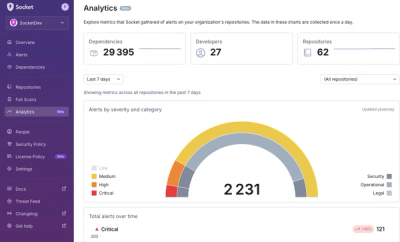
Product
Introducing Socket Fix for Safe, Automated Dependency Upgrades
Automatically fix and test dependency updates with socket fix—a new CLI tool that turns CVE alerts into safe, automated upgrades.
Writing a Dash web application gives a lot of flexibility, however, it also requires :snake: Python knowledge from the person setting it up.
Webviz™ is a MIT-licensed configuration layer on top of Dash, which encourages making reusable components and dashboards, which can then be added/removed when creating an application using a short yaml configuration file.
This Python package, webviz-config, is the core plugin framework. For a real example repository using this plugin system, see e.g. webviz-subsurface.
These are the main user groups targeted by Webviz™:
Webviz™ will create web applications with very :lock: strict security headers and CSP settings, giving an rating of A+ on e.g. Mozilla observatory. It also facilitates a :whale: Docker setup, where the Python code can be ran completely unpriviliged in a sandbox (both with respect to file system access and network communication).
Example configuration file and information about the standard plugins can be seen in the documentation.
The workflow can be summarized as this:

The recommended and simplest way of installing webviz-config is to run
pip install webviz-config
If you want to develop webviz-config and install the latest source code manually you
can do something along the lines of:
git clone git@github.com:equinor/webviz-config.git
cd ./webviz-config
npm ci --ignore-scripts
# NOTE: If you are on Windows, make sure to first set `npm`'s default `script-shell` to `powershell` by running
# npm config set script-shell powershell
npm run postinstall
pip install -e .
After installation, there is a console script named webviz available. You can test the
installation by using the provided example configuration file,
webviz build ./examples/basic_example.yaml
Without any additional arguments, this will
When stopping the server (press CTRL+C at any time), the temporary folder is deleted.
The optional arguments can be seen when running
webviz --help
See the introduction page for information on how you
create a webviz configuration file and use it.
If you are interested in creating new plugins which can be configured through the configuration file, take a look at the contribution guide.
To quickly get started, we recommend using the corresponding cookiecutter template.
webviz-config is, with a few exceptions listed below, MIT licensed.
FAQs
Configuration file support for webviz
We found that webviz-config demonstrated a healthy version release cadence and project activity because the last version was released less than a year ago. It has 1 open source maintainer collaborating on the project.
Did you know?

Socket for GitHub automatically highlights issues in each pull request and monitors the health of all your open source dependencies. Discover the contents of your packages and block harmful activity before you install or update your dependencies.

Product
Automatically fix and test dependency updates with socket fix—a new CLI tool that turns CVE alerts into safe, automated upgrades.

Security News
CISA denies CVE funding issues amid backlash over a new CVE foundation formed by board members, raising concerns about transparency and program governance.

Product
We’re excited to announce a powerful new capability in Socket: historical data and enhanced analytics.